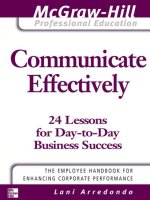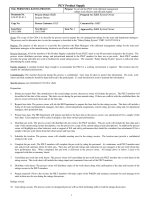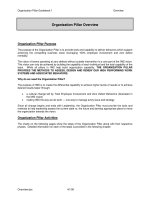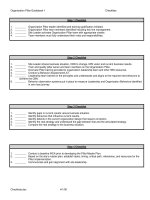Tài liệu Organization effectiveness pdf
Bạn đang xem bản rút gọn của tài liệu. Xem và tải ngay bản đầy đủ của tài liệu tại đây (308.1 KB, 14 trang )
The newly defined Core Competencies of the HR Function fully integrate the skill areas
included in many previous definitions of the Organization Effectiveness, Organization
Development and Organization Excellence skill bundles. For many years these were viewed as
separate and distinct skills which some have found difficult to reconcile, define or codify.
Actually, the HR Core Skills/Core Competencies for 0-2005 do just that; these critical
capability-building skill areas are defined in the context of the business and HR's new role -
the
4-Quadrant Model - and are positioned in business units where they are used by HR practitioners
with line leaders and their leadership teams to focus on building individual and organizational
capability to enable delivery of business strategies.
1. What is Organization Effectiveness
2. O.E and the 0-2005 Transformation
3. O.E and the HR Core Competencies
4. The O.E Toolbox
5. Resource Materials
This site is designed for those charged with/working to build individual and organizational capability to
achieve results. It includes tools and materials which may be useful to the practitioner. If you are aware of
other tools which you feel should be included, please let the site owner know under "Feedback".
One last comment about the manner in which OE is managed in P&G. We practice OE by developing
practitioners in the business, not by employing internal or external consultants which aren't a part of our
line businesses. HR focuses on developing its own expertise, and the expertise of line leaders, by
applications in doing the work and focusing on hard number results.
4 Quadrant Model
This diagram shows how the core competencies of HR integrate into the role of HR
Organization Effectiveness or "OE" is a term used to describe the philosophies, tools and the
skills important for developing individuals and organizations capable of competing more
effectively. The current technology has evolved over time with a number of "schools of
thought" and became valued as important and useful in improving results. It embraces working
with teams and individuals to understand and improve the work as well as the social and
interpersonal relationships and behaviors critical for ensuring that people and groups work
together efficiently and effectively to achieve the objectives of the organization: the human
side of the enterprise. It also includes using group and organizational dynamics to design
structures to aid in the achievement of objectives: the organizational side of the enterprise.
While there are many schools of thought and numerous approaches and techniques, the
fundamental elements of OE technology are simple and common. It's on those simple,
business-centered approaches that we want to focus.
OE Defined
Earlier in its evolution, this same body of knowledge and practice was generally referred to as "OD" or
Organization Development, as it centered on developing people and organizations toward improving business
numerics. Later in P&G it became known as Organization Excellence. This notion split it off from Human
Resources (HR) processes focused on People Excellence -- the areas supporting traditional HR work:
Compensation, Employee Relations, Labor Relations, etc.
There has long been a need to clarify and reconcile the concept and names of OE, since many practitioners
recognize that there is no "one
best" OE philosophy, and many professionals waste time debating which tools and
approaches are best. This distracts us as focus moves to process rather than the business. Recognizing this debate,
HR has identified the various tools, skills and competencies needed to bring this important technology to bear
favorably on our business and incorporated them into HR's Core Competencies. Click on
HR Core Competencies
Website for more detail.
Importance of OE
The stakes for practitioners of OE work are high, whether the professional is counseling leadership or
implementing and driving a change in support of leadership. If the interventions are wrong...focus is shifted, the
business is disrupted, and people are distracted...all costing time, money and a potential loss of competitiveness.
Costs we cannot well afford.
There are historically five fundamental technology bundles and a few, simple, supporting tools foundational in all
our OE work. These include:
. Organization Assessment and Design
. Change Management and work re-design
. Development of High Performing Teams/ Organizations
. Development and Deployment of Business Direction
. Consulting Leaders
(Click on the OE toolbox FOR EXAMPLES)
Where is OE Used
All OE work should be focused solely on improving operating results in the business. This means reduced costs,
reduced cycle time, improvements in productivity or increased creativity and innovation which improve our odds
for success via products or systems improvements or enabling market competitiveness. OE Technologies are
applied to gain individual and organizational improvements in a strategic manner in MDOs, GBUs, GBS or in
corporate functions by skilled practitioners assigned to each.
Measuring OE Interventions
All OE interventions should answer the question "what problem if addressed will improve operating results?"
Once this is identified, clear, numerical measures should be selected to evaluate the outcome of OE work in the
context of improving the business. For example....P&G is reorganizing itself into MDOs, GBUs and GBS to
ensure growth to $70B in NOS by 2005. So, OE work to make changes in an MDO, for example, should measure
whether NOS is favorably impacted by making the change. If they can't be clearly quantified, OE interventions
should not be made. All OE interventions should have a measure stated like: "Improve NOS from "x" to "y" by
6/30/00 from completing "z" project/change."
P&G has decided, based on an analysis of its results, future trends, changing consumers, and
an ever changing global competitive environment, to re-invent or re-design itself. OE tools
and skills are a critical part of this work to ensure success. This change will be accomplished
by a series of OE interventions successfully managed across time. HR's role is at the center
of all of this, with every business team, in every business unit.
OE in the new age 0-2005
Moving the organization into the digital age has opened tremendous opportunities for HR professionals involved
in making the changes needed to transform our businesses. OE technologies are used to manage these changes
involving such things as strategy development, organization re-design, transition management and downsizing or
upsizing to name a few.
Tools for Making Change
In P&G's O-2005 change effort, HR practitioners will apply the basic elements of OE outlined in the HR Core
Competencies to varied degrees in most every HR assignment. For example, those working in business units like
MDOs and GBUs will use tools focused on team effectiveness, strategy development and managing cultural
changes centered on aligning people with strategies to improve speed and competitiveness. Practitioners o
in roles in the Administration Expert and Employee Champion components of the HR role, like GBS or the Core
Functions, may use OE technologies to improve work processes and systems to reduce complexity and costs; thus
streamlining cycle time to enhance company competitiveness.
OE and HR Core Competencies
Re-balancing the role of HR for 0-2005 using the 4 Quadrant role model has placed emphasis on the few core
skills critical for supporting the delivery of hard number results in business units. Each competency incorporates
OE technologies in an action oriented, user friendly way to enhance personal and organizational growth to
improve contributions.
perating
OE has long been a separate skill area with little structure in P&G; yet we have had world
class practitioners with pockets of excellence all over the Company. Given the changes
needed for competing in the new world of 0-2005, HR has successfully integrated the key
OE technologies into the core work of business units for delivering P&G's business
strategies.
New World HR Competencies
The creation of these new "core" skill bundles integrates all of the "old"/traditional elements included in OE/OD
and Organization Excellence. Click on
HR Core Competencies.
How OE is Used in Each Competency
OE in Understanding the Business
OE skills are at the heart of this core competency. HR professionals must assist in the Development, Deployment,
Review and Renewal of Business Strategies and have the organizational skills needed for focusing and aligning
people and organizations with these strategies to improve operating results.
OE in Driving Change and Managing Transformation
This competency incorporates planning, managing and measuring change efforts designed and initiated to close
the "gaps" between where the organization is and where it needs to be to deliver business strategies. It includes
expertise in Organization Assessment, Organization Design and Change Management.
OE in Creating and Managing Culture
This competency includes skills needed to create the "culture" to achieve Business Strategies. This includes
designing organizations, redesigning work processes and systems, creating structures, information,
communication and decision making systems, the development and deployment of people, and the creation of
reward and recognition systems to support achieving the business strategies.
OE in the Management of HR Practices/Delivering HR Basics
This competency area focuses on providing employee support and the systems and processes involved in day-to-
day operations of traditional HR programs, without disruption or distraction to operations. It also includes
developing High Performing Work Systems and effective management of costs. OE tools/skills are used to link
HR's work to the business and in managing constant change and improvement.
OE in Creating Personal Credibility and Influence
This core skill is fundamental to HR's ability to successfully select and manage organizational interventions with
leaders, their leadership teams, and their organizations. HR's impact and influence...its very ability to lead...comes
from the personal credibility of its practitioners to contribute successfully in these roles by favorably impacting
hard number results via OE tools.
To ensure we have resources with the skills needed to create the necessary "fit" between our
culture and our strategies, practitioners must be developed in the application of the Core
Competencies of HR through training, networking, and actual work experience. Applying
these competencies holistically ensures the ability to develop capabilities needed for
individuals and organizations to favorably impact hard number results. The process for
developing people is managed through the Leadership Learning and Development unit of the
core HR Function and directly by practitioners in the Business Units. In addition to creating
Development Systems to operationalize these skill areas, HR has organized a network of
global practitioners and "Mastery" level experts to ensure constancy of purpose and continual
improvement. This supports the stated mission of HR; Creating the Individual and
Organizational Capabilities needed to achieve Business Results. Both the Development
System and the HR Network of Practitioners will ultimately link to the R&D for HR
component in the Core Function of HR, and to practitioners in line business units.
OE Tools for Organization Assessment and Design
These are overarching organizational models which guide practitioners in thinking about all aspects of a change,
and the interventions to organize and manage each aspect holistically. They involve steps or questions helpful in
moving to action once the problem or opportunity statement for the change is developed.
Click here for
examples.









